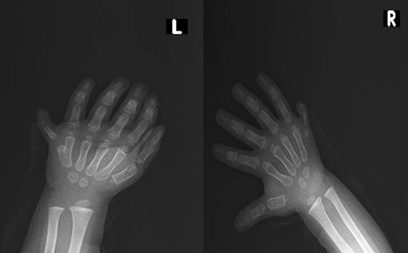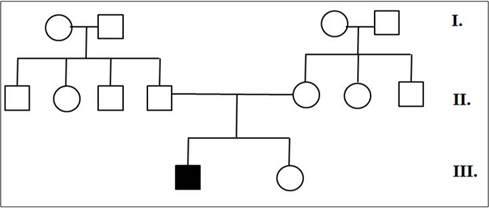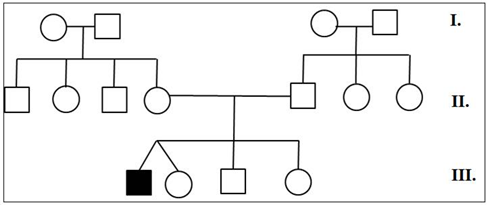Case Report
Volume 2 Issue 1 - 2018
A Novel Variant that may be Associated with Congenital Malformation in HOXD13
1Department of Medical Biology, Meram Faculty of Medicine, Necmettin Erbakan University, Konya, Turkey
2Department of Plastic Reconstructive and Aesthetic Surgery, Meram Faculty of Medicine, Necmettin Erbakan University, Konya, Turkey
3Department of Plastic Reconstructive and Aesthetic Surgery, Health Practice and Research Hospital, Balıkesir University, Balıkesir, Turkey
2Department of Plastic Reconstructive and Aesthetic Surgery, Meram Faculty of Medicine, Necmettin Erbakan University, Konya, Turkey
3Department of Plastic Reconstructive and Aesthetic Surgery, Health Practice and Research Hospital, Balıkesir University, Balıkesir, Turkey
*Corresponding Author: Assoc.Prof. Dr. Hasibe VURAL, Necmettin Erbakan University, Meram Faculty of Medicine, Dept of Medical Biology, Meram/Konya Turkey.
Received: May 30, 2018; Published: June 06, 2018
Abstract
Background: HOX genes, a subgroup of homeobox genes, found in as gene clusters in mammals, are the most important regulators of morphogenesis and cell differentiation, and also these genes control the main body axis during embryogenesis. One of these genes, HOXD13, known to be associated with developmental disorders especially congenital lower/upper limb abnormalities such as syndactyly and polydactyly.
Case Report: In this report we present two patients, one case of syndactyly and one case of polydactyly. In the first case, there was a syndactyly in the between 2nd and 3rd fingers of right hand, and there were extra fingers in both hands in the other case.
Conclusion: This case report provides a new variation (c.204G> A) which can be associated with dactyly malformations in HOXD13 gene.
Keywords: HOXD13; Next generation sequencing; Polydactyly; Syndactyly
Introduction
Dactyl malformations are developmental disorders, and they are the most common congenital extremity anomalies in hand and foot. Brachydactyly, syndactyly and polydactyly are the most common types of dactyl malformations, and the phenotypic reflections of these malformations differ. Brachydactyl phenotype is characterized by disproportionately short hands and/or toes. Syndactyly is formed by the failure to break apart of the curled-combined hand and/or toes in embryo, more than 5 finger shaped in hand and/or feet is observed in polydactyly [1-2]. And also, many subclasses of typed malformations have been described in the literature. Especially the classification of the syndactyly and polydactyly anomalies is made according to morphology and settlement place of the anatomical structure which is excess or united [3]. The studies have shown that inheritance model of syndactyly and polydactyly, which are seen as isolated, is the autosomal dominant, while inheritance is autosomal recessive when the phenotype coexists with additional pathologies [4].
The homeodomain containing HOX genes are a family of highly conserved primer transcription factors that control the fate and local identity of the cell throughout the body and extremity axis [5]. HOXD13 is the first HOX gene known to be associated with developmental disorders in human. Mutations in HOXD13, which have a critical role in limb development, may play a role in the development of variable expression of clinical manifestations in malformations such as syndactyly and polydactyly [2]. The goal of this report is to identify the genetic etiology of dactyl malformations as associated with HOXD13 gene. For this, two cases were included in the study and the cases were screened for possible mutations in HOXD13 using next generation sequencing (NGS) method.
Case Presentation
The study was approved by the Ethics Committee of XXX University. Blood samples were collected after informed consent was obtained. We evaluated two family which are containing one polydactyly and syndactyly cases. In the first case, there was a syndactyly in the between 2nd and 3rd fingers of right hand (Figure 1). In the other case, there were extra fingers in both hands (Figure 2). In the case of two patients, no signs of disease were found in the other organ systems.

Figure 1: X-ray image of the first case; the syndactyly malformation
between 2nd and 3rd fingers of the right hand.
In the first case, the combined 2nd and 3rd fingers of right hand have been separated with the surgical operation. For polydactyly excision additional fingers on both hands in second case have been disjointed with surgery. And also, according to the pedigree analysis, it was determined that no other individuals with similar anomalies were present in the patients' families (Figure 3,4).
According to the results of the NGS analysis; in the first case, no mutation was found in the HOXD13 gene. In the second case, c.204G > A single nucleotide exchange was observed in exon 1 of HOXD13 gene. And then, the patient's parents were screened for HOXD13 mutations. According to the results, while the same variation was detected in the father of the patient, c.441G > A variation was determined in the mother of the patient addition to c.204G > A in exon 1 of HOXD13 gene. Nonsynonymous or amino acid-altering mutations are further classified into missense and nonsense mutations. A point-nonsense mutation differs from a missense mutation, which is a point mutation where a single nucleotide is changed to cause substitution of a different amino acid. Summarly, we were performed with appropriate primers to generate HOXD13 carrying the c.204G > A and the other c.441G > A mutation. The specific base changes were verified by DNA sequencing using NGS. HOXD13 sequencing revealed a heterozygous G-to-A transition in exon 1 at position 204 of the coding sequence in all the affected people of this family. The c.204G > A and c.441G > A from novel mutations accounted for the clinical phenotype.in this study. Furthermore, circumstances, determine or these mutations occur when the change of a single DNA nucleotide within a protein-coding portion of a gene does not affect the sequence of amino acids that make up the gene's protein. A change in one nucleotide, however, doesn't always change the triplet's meaning; the mutated triplet may still add the same amino acid. And when the amino acids of a protein stay the same, we believed, so do its structure and function.
Discussion
The HOXD13 gene, located at the 5' end of the HOXD gene cluster localized on chromosome 2q31, is 1365 bp and its coding region is 1008 bp. The first exon located at the 5' end of the gene, comprising of two exons, contains the triple repeat sequences forming the chain of polyalanine, while the second exon located at the 3' end encodes a highly conserved homologous box domain [6]. HOXD13 gene mutations are known to cause variable expression in a wide spectrum of clinical manifestations of extremity malformations [7].
The mutations observed in the HOXD13 gene are examined in three groups; loss of function mutations, increase in N-terminal polyalanine repeat, and missense mutations [8]. Until now five missense mutations (R298W, R298Q, S308C, I314L, and Q317R), are placed in gene’s homeodomain and are associated with dactyly malformations in different phenotypes, have been identified [9]. Nonsense and frame-shift mutations are thought to cause haploinsufficinency of the HOXD13 protein, but this has not yet been confirmed experimentally [10,11].
Two cases, included in this study, were syndactyly and polydactyly. According to the pedigree analysis of the cases, there was no dactyl malformation in the family's story of the patients.
According to the NGS analysis results, no mutation in the HOXD13 gene was detected in the case of the syndactyly. In addition to the HOXD13 gene, other members of HOX gene family can be effective in developmental malformation. It is known that the expansion of the polyalanine in the HOXA13 gene is responsible for the development of the syndactyly. It is thought that the responsible gene can be HOXA13 in this case, too; so further analysis should be extended to cover all HOX gene cluster members.
However, in the case of polydactyly, c.204G > A variation was detected in the exon 1 of HOXD13 gene. The same variation was also found in the parents of the patient. And, it was observed that the patient's mother had also carried a c.441G > A variation. In the literature, there have been no studies showing the association of these variants observed in the HOXD13 gene with dactyl malformations. Dactyly malformations usually show autosomal dominant inheritance. In agreement with this, the variation observed in our polydactyly case was also detected in parents. However, the phenotype observed in the patient did not appear in the family. As the reasons of this, the differences of penetrance/expressivity in reflection of genotype to phenotype can be shown.
It is important to investigate whether the disease has emerged due to a new mutation in a person, has normal parents, with an autosomal dominant inherited disorder. In this study, we evaluated the association of dactyly malformations known to be autosomal dominantly inherited and HOXD13 gene variants. The results show that a new variant may be associated with dactyly malformations. However, this variation should be scanned in large populations to arrive at a definite judgment. In addition, gene expression studies should be performed to clarify the underlying mechanisms of phenotypic differences observed within the family.
References
- Schwabe GC and Mundlos S. “Genetics of congenital hand anomalies”. Handchirurgie, Mikrochirurgie, Plastische Chirurgie 36.2-3 (2004): 85-97.
- Jordan D., et al. “The epidemiology, genetics and future management of syndactyly”. The Open Orthopaedics Journal 6 (2012): 14-27.
- Blauth W and Olason AT. “Classification of polydactyly of the hands and feet”. Archives of Orthopaedic and Trauma Surgery 107.6 (1988): 334-344.
- Eze KC., et al. “Isolated dextrocardia with bilateral undescended testis and bilateral polydactyl of the hands and feet: a case report”. Nigerian Postgraduate Medical Journal 15.1 (2008): 61-63.
- Kurban M., et al. “A nonsense mutation in the HOXD13 gene underlies synpolydactyly with incomplete penetrance”. Journal of Human Genetics 56.10 (2011): 701-706.
- Akarsu AN., et al. “Genomic structure of HOXD13 gene: a nine polyalanine duplication causes synpolydactyly in two unrelated families”. Human Molecular Genetics 5.7 (1996): 945-952.
- Goodman FR. “Limb malformations and the human HOX genes”. American Journal of Medical Genetics 112.3 (2002): 256-265.
- Brison N., et al. “Joining the fingers: a HOXD13 Story”. Developmental Dynamics 243.1 (2014): 37-48.
- Dai L., et al. “Mutations in the homeodomain of HOXD13 cause syndactyly Type 1-c in two Chinese families”. PLoS ONE 9.5 (2014): e96192.
- Ibrahim DM., et al. “A homozygous HOXD13 missense mutation causes a severe form of synpolydactyly with metacarpal to carpal transformation’. American Journal of Medical Genetics Part A 170.3 (2016): 615-621.
- Identification of a missense HOXD13 mutation in a Chinese family with syndactyly type I-c using exome sequencing. Hao Deng, etc. Molecular Medicine Reports. DOI: 10.3892/mmr.2017.6576.
Citation:
Hasibe Vural., et al. “A Novel Variant that may be Associated with Congenital Malformation in HOXD13”. Medical Research and
Clinical Case Reports 2.1 (2018): 127-131.
Copyright: © 2018 Hasibe Vural., et al. This is an open-access article distributed under the terms of the Creative Commons Attribution License, which permits unrestricted use, distribution, and reproduction in any medium, provided the original author and source are credited.






































 Scientia Ricerca is licensed and content of this site is available under a Creative Commons Attribution 4.0 International License.
Scientia Ricerca is licensed and content of this site is available under a Creative Commons Attribution 4.0 International License.